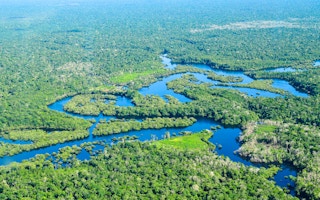In the last decade, the Amazon forests of Brazil released more carbon into the atmosphere than they absorbed, thanks largely to human activities that cleared or degraded the canopy. Those activities make it impossible for affected forests to stave off climate change.
And a survey of the cooler forests of North America has revealed that these, too, could be surrendering more carbon than they soak up from the atmosphere, thanks to human-triggered climate change and the ever greater hazard of wildfire.
The world’s forests are a key part of the great carbon conundrum: what happens to all the greenhouse gases emitted from power stations, vehicle exhausts and factory chimneys? The assumption is that approaching one third of all the carbon dioxide emissions are absorbed by the forests, and the conservation of the planet’s forests has become part of the proposed arsenal of global defence against catastrophic climate change.
Researchers have repeatedly confirmed that, undisturbed, the world’s great natural forests are important reservoirs of atmospheric carbon. They have also confirmed that, even without taking carbon sequestration into account, the forests represent precious natural capital: they are worth more to humankind undisturbed than they could ever be as sawn timber or ranchland.
But the world’s forests are not being left alone: one study found that even many of those ecosystems set aside by national law for protection are being destroyed or damaged.
And the simple equation that an area of tree canopy represents so much carbon drawn down from the atmosphere turns out not to be so simple. A warming climate − and the planet as a whole is more than 1°C on average warmer than it was a century ago − can disturb the calculations.
As the thermometer notches up, trees grow faster and die younger; they also grow shorter and the extra fertility conferred by an atmosphere richer in carbon could result in a richer spring growth that is not sustained over a longer summer season. As the temperature rises, so the character of the forests could change: some species may one day find it too hot to reproduce.
And then there is the direct effect of climate change driven by rising temperatures: with heat comes drought, and the greater risk of fire. Forests that had once been reservoirs of carbon could start to surrender it to accelerate climate change even more. The marvel that is the Amazon rainforest could, one researcher has warned, collapse altogether and change irrevocably in one human lifetime.
Degradation costs more
Both of the latest studies deliver evidence that, over time, this could already be on the cards. Scientists from the US, France, Denmark, the UK and China report in the journal Nature Climate Change that they worked through a vast collection of satellite data to calculate the levels of what they call “above ground carbon” − the mass of the element incorporated in timber and foliage − in the Brazilian Amazon between the years 2010 and 2019.
They worked out that in that decade, the growing forest gained 3.79 billion tonnes of carbon, but degradation or destruction of the forest resulted in a gross loss of 4.45 billion tonnes. And degradation − basically disturbance by humans in the shape of roads, or plantations, or mining or quarrying − was three times more costly in carbon terms than actual forest clearance.
“Forest degradation has become the largest process driving forest loss and should become a higher policy priority,” the authors say.
A second study in the same journal confirms a parallel finding over 2.82 million square kilometres of Alaska and western Canada. Researchers from the US looked at three decades of satellite data, from 1984 to 2014, to calculate that over those 30 years this area of boreal forest gained 434 billion tonnes of mass in the form of timber and foliage above ground. But forest fires also surrendered 789 billion tonnes of mass over those years.
Intact forests vital
The forests recovered − that is, new growth replaced the lost − but in that time only by 642 billion tonnes. Timber millers took 74 billion tonnes, and new growth added 32 billion tonnes in return. Above-ground mass is not the same thing as above-ground carbon, but it doesn’t change the big picture.
And the big picture is that any disturbance alters the value of forests to the atmospheric traffic in carbon. Within that is a warning to those scientists who have to calculate the global carbon budget: humans may have been over-estimating the capacities of the forests.
“It’s not enough for a forest to absorb and store carbon in its wood and soils. For that to be a real benefit, the forest has to remain intact,” said Jonathan Wang, of the University of California at Irvine, who led the study.
“The far north is home to vast, dense stores of carbon that are very sensitive to climate change, and it will take a lot of monitoring and effort to make sure these forests and their carbon stores remain intact.”
This story was published with permission from Climate News Network.

















